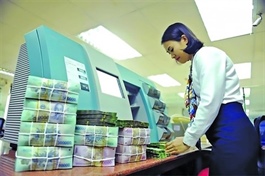Banks basically disclose lending rate information on websites
Banks basically disclose lending rate information on websites
Commercial banks have basically published information on lending interest rates on their websites, according to the direction of the Prime Minister, the State Bank of Vietnam (SBV) said.

Customers make transactions at a bank in Hà Nội. Many banks, including ABBank, have published information on their lending interest rates on their websites. — VNA/VNS Photo |
In addition to the lending interest rates, the banks have also disclosed the interest rate gap of deposits and loans, as well as the lending interest rates for preferential credit packages.
As one of the first banks to publicly disclose lending interest rates on its website, BIDV, currently the bank with the leading lending market share in the banking system with VNĐ1.74 quadrillion, currently lists the average lending interest rate in March 2024 at 6.49 per cent per year.
The gap between BIDV's average lending interest rate and its average capital mobilisation interest rate is 3.12 per cent per year.
Similarly, TPBank announced an average lending interest rate of 7.76 per cent per year, of which the average lending interest rate for individual customers and corporate customers is 8.85 per cent and 7.34 per cent, respectively.
The average interest rate difference between deposits and loans at TPBank is 3.75 per cent.
A number of other banks have also publicly announced the average lending interest rates and loan package information such as VIB, Sacombank, ACB, ABBank, LPBank and BacABank.
The SBV required commercial banks to disclose information about lending interest rates before April 1 this year, given the banking system's declining credit. According to the SBV, the banking system's credit as of February 16 this year decreased by 1 percent compared to the end of last year.
Experts are concerned about the credit decrease in the first two months of 2024 because this year's conditions are different from the previous years, as the SBV assigned the year’s entire credit growth quota of 15 per cent for commercial banks right in the first month of this year, instead of only allocating a part of the quota at the beginning of the year as previously.
Early this month the SBV also sent an official dispatch to credit institutions stating that despite the application of supporting policies to boost credit from the beginning of the year, credit growth this year is still quite low compared to recent years.
To boost credit growth, the SBV requested credit institutions to firmly implement effective credit growth solutions right from the beginning of the year. Credit must focus on production, business and the Government’s priority sectors, as those are the country’s economic growth drivers. Banks also need to strictly control credit for potentially risky sectors to ensure safe and effective operations.


























